The Ebola story has criss-crossed the globe and come home to our living rooms via news reports showing the latest quarantines and body counts. You’ve seen the powerful images that depict West African communities grappling with the ravaging effects of the disease.
We’ve lost one of the Ebola story's primary documentarians, and a mentor of mine, with the death of Washington Post photographer Michel du Cille while on assignment in Liberia on Thursday.
Du Cille suffered an apparent heart attack just days after he returned from a four-week vacation to continue photographing the virus’ impact at ground zero, according to Post executive editor Martin Baron.
I first learned of du Cille’s tragic passing on Facebook.
Shock went through me when I read the Washington Post link telling us the 58-year-old had died.
"Deep in my heart and soul I know that Michel died doing what he loved! Giving voice to a story he felt compelled to do with all HIS heart and soul. It doesn't make this any easier but it is what I will cling to as I mourn the love of my life,” wrote his wife Nikki Kahn, also a Post photographer.
Kahn shared a photo of du Cille waving goodbye to her the last time he departed for Liberia.
U.S. & World
The three-time Pulitzer Prize winner is a journalism giant, one of those people who you wish in your wildest dreams you might get to meet and work with.
His photos of crack cocaine addicts at a Miami housing project scored him his second Pulitzer in 1988 while working at the Miami Herald. I was in awe the first time I viewed his images as a photojournalism student at Syracuse University more than 20 years ago.
How did he have the presence of mind to click his camera and capture marquee moments in such stressful situations?
That was a skill I desired to learn as I studied the great modern photojournalists.
As an up-and-coming photojournalist in the '90s, I scored the internship of my dreams when the Washington Post hired me for the summer of 1996, giving me the opportunity to work with du Cille, Dudley Brooks, Michael Williamson, Carol Guzy, Joseph Elbert and dozens of other photographers I admired.
Du Cille was a fixture at the Post light table, poring over oodles and oodles of color film with his loupe. This was before digital cameras, smartphones and instant posting to social portals, requiring a discussion with a picture editor as part of your workflow.
This was during an era when visual journalism and photojournalism was hailed at newspapers and the staff size reflected that. Today, U.S. newspapers are staffed with reporters carrying iPhones, and the downsized photo departments are so small you can often count the number of photographers on two hands, or less.
Serious, pensive and quiet was du Cille’s picture editing style.
I can’t lie. I was scared of a Michel du Cille edit. He was tough and difficult to read.
Du Cille was fond of an image I took that summer of a black ballet dancer whipping across the dance floor. The horizon line was tilted, and I wasn’t sure he’d like that, but he did. I talked with him about how I had lain on the ground awkwardly, almost up-skirting the dancer to capture the moment. I must have shot two rolls of film or 72 frames just to get the right moment, which was turned into a Post promotional mouse pad.
I knew du Cille always viewed me as a kid, but three years after the internship, I became one of his counterparts as a staff photographer at the Philadelphia Inquirer.
I saw du Cille over the years at photo workshops and conventions, such as the annual National Association of Black Journalists gathering. It was a treat to reconnect and hear him tell the story of how he made his images that year. He returned to shooting full-time in 2012.
Du Cille’s Ebola images grace the National Press Photographer Association’s News Photographer magazine as the October cover story.
I studied those photos standing at a post office table, just moments after fetching it from my post office box. As I stood there, I said to myself: This man is going to win his fourth Pulitzer Prize.
One image shows a body being loaded into a pickup truck, with an Ebola awareness poster nearby that says, “Always wash your hands.” And there’s another of workers covered head-to-toe in white protective gear carrying a body bag as they walk by a clothes line full of children’s clothing.
But my favorite is a double-truck image of women rejoicing with multi-colored umbrellas as a nurse was released from an Ebola treatment center after recovering from the virus.
Du Cille brought a human perspective to the ravaging impacts of the virus with his images, and he fought to do so till his last breath.
His impact on scores of photojournalists like me and readers reminds us why visual journalism helps to ensure the public's trust.
We need visual soldiers who are willing to fight to document the story just like du Cille did.
Sarah Glover is the social media editor for NBC Owned Television Stations.



